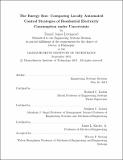| dc.contributor.advisor | Richard C. Larson. | en_US |
| dc.contributor.author | Livengood, Daniel James | en_US |
| dc.contributor.other | Massachusetts Institute of Technology. Engineering Systems Division. | en_US |
| dc.date.accessioned | 2012-01-11T20:18:02Z | |
| dc.date.available | 2012-01-11T20:18:02Z | |
| dc.date.copyright | 2011 | en_US |
| dc.date.issued | 2011 | en_US |
| dc.identifier.uri | http://hdl.handle.net/1721.1/68190 | |
| dc.description | Thesis (Ph. D.)--Massachusetts Institute of Technology, Engineering Systems Division, 2011. | en_US |
| dc.description | This electronic version was submitted by the student author. The certified thesis is available in the Institute Archives and Special Collections. | en_US |
| dc.description | Cataloged from student submitted PDF version of thesis. | en_US |
| dc.description | Includes bibliographical references (p. 109-121). | en_US |
| dc.description.abstract | The Energy Box is an always-on background processor automating the temporal management of one's home or small business electrical energy usage. Cost savings are achieved in a variety of environments, ranging from at pricing of electricity to real-time demand-sensitive pricing. Further cost savings derive from utilizing weather forecasts to manage local rooftop wind turbines or solar photovoltaics and/or to anticipate price swings from central utilities. The main motivation of this research is to design, construct and test a prototype software architecture for the Energy Box that can accommodate a wide variety of local energy management environments and user preferences. Under some scenarios, appliances can be optimally controlled one at a time, independent of each other. In other scenarios, coordinated control of appliances, either simultaneous or time-sequenced, provide better outcomes. Stochastic dynamic programming is the primary optimization engine. The optimization goal is to balance cost minimization with thermal comfort as specified by consumer preferences. The results demonstrate that the desired general energy management platform is feasible as well as desirable for saving money on electricity while maintaining comfort preferences. Scaling up to neighborhoods, towns and cities, a key contribution is improved understanding of single-home electricity demand dynamics induced by automated decisions. Further research will determine how such local automated decisions affect the broader smart grid with regard to resilience, stability and pricing. | en_US |
| dc.description.statementofresponsibility | by Daniel James Livengood. | en_US |
| dc.format.extent | 142 p. | en_US |
| dc.language.iso | eng | en_US |
| dc.publisher | Massachusetts Institute of Technology | en_US |
| dc.rights | M.I.T. theses are protected by
copyright. They may be viewed from this source for any purpose, but
reproduction or distribution in any format is prohibited without written
permission. See provided URL for inquiries about permission. | en_US |
| dc.rights.uri | http://dspace.mit.edu/handle/1721.1/7582 | en_US |
| dc.subject | Engineering Systems Division. | en_US |
| dc.title | The Energy Box : comparing locally automated control strategies of residential electricity consumption under uncertainty | en_US |
| dc.title.alternative | Comparing locally automated control strategies of residential electricity consumption under uncertainty | en_US |
| dc.type | Thesis | en_US |
| dc.description.degree | Ph.D. | en_US |
| dc.contributor.department | Massachusetts Institute of Technology. Engineering Systems Division | |
| dc.identifier.oclc | 770698097 | en_US |
